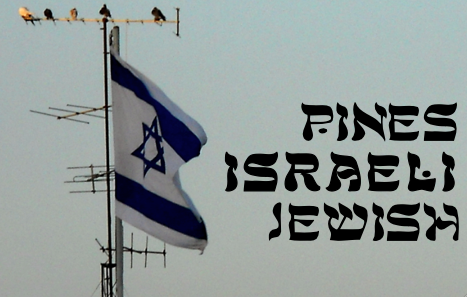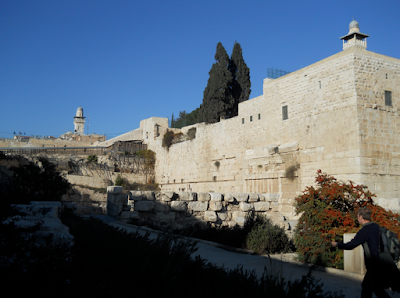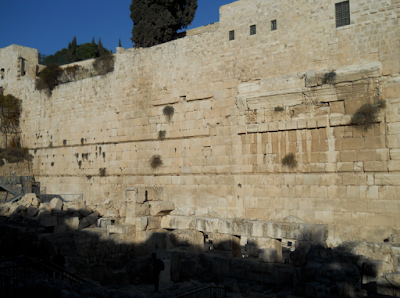Following a relaxing shabbat weekend with the Elbaum family in Modi'in, Sunday was completely spent studying for my Hebrew midterm--
bachinat emtzah--on Monday. This test covered everything learned in level
aleph as well as everything learned in level
bet so far. To prepare, I had to look back at hundreds of vocabulary words in addition to reviewing all the grammar rules, especially tense conjugations and prepositions. Hebrew is much more complex than English, so there is a lot more to keep in mind as a beginner. In English for example, saying "I will think," "you will think," "he/she will think," "we will think," and "they will think" all end in "will think." This is not too complicated as long as one remembers the proper pronouns. In Hebrew, however, "I will think" is "
achshohv;
" "you will think" is "
tachshohv" for a male and "
tachshvee" for a female; "he will think" is "
yachshohv;" "she will think" is "
tachshohv," which is the same as "you will think" for a male; "we will think" is "
nachshohv;" and "they will think" is "
yachshvoo." Confusing enough? It is not easy to remember which prefix to add, when to add a suffix, and when to drop the letter
vav. Multiply that for hundreds of different verbs, and it is possible to see why this is such a complex language!
Today, I went on a field trip to the archeological excavations in the Herodian Quarter of the Old City of Jerusalem. After Israel captured the city form the Jordanians in 1967, Israeli archeologists began excavating the destroyed Jewish Quarter. During this process, hundreds of First and Second Temple ruins were exposed. Today, several of these excavations are still available for the public to view in the restored Jewish Quarter. Here are some images from my trip:
As we drove by Al-Aqsa Mosque, we got a taste for some of the Second Temple period ruins we would be looking at later.
We entered the Old City through Zion Gate, which bears the battle scars of the 1948 War of Independence.
The Broad Wall is a First Temple period city wall dating back to King Hezekiah. The blue and white measuring stick to the left shows the original height of the wall.
Ruins of the home of a wealthy family underneath a modern-day yeshiva.
Steps into a mikveh led archeologists to believe this was the home of a Jewish priest, or kohain in Hebrew. Notice the small bowl at the top of the stairs for cleaning one's feet. Also, the edge of a mosaic--a sign of wealth--is visible in the top left corner of the picture.
Remains of various types of columns. The ornate design to the left is of the Corinthian order, the middle design is of the Ionic order, and the simple design to the right is of the Doric order.
Signs of wealth: In addition to a mosaic, this house included fancy pottery and a stone table.
A model of what the excavated house (really a mansion) would have looked like in the days of the Second Temple.
Evidence of the destruction of Jerusalem in 70 CE include burnt remains and charred walls.
When we were done with the excavations under the yeshiva, we arrived at the Golden Menorah. This menorah is a rough recreation of the menorah found in the Second Temple. It is based on the design carved into the Arch of Titus in Rome, which celebrates Rome's conquering of Jerusalem by Emperor Titus.
Here I am in 2007 in front of the Arch of Titus.
A beautiful view of the Western Wall and the Dome of the Rock.
The second half of our trip consisted of a tour of the Jerusalem Archeological Park.
The path into the archeological park features a timeline of the rulers of Jerusalem, from the Caananites to the modern-day Israelis.
A ruin of the Second Temple featuring a swastika. Little did the designer know that millions of his descendants would be murdered under this symbol thousands of years later.
The corner of the Temple Mount, looking in the direction of the Western Wall.
Al-Aqsa Mosque, looking towards the Mount of Olives.
Robinson's Arch used to be a stairway that carried traffic from the street-level market to the basilica, known as the Royal Stoa, on the Temple Mount.
An excavated mikveh that still functions when it rains.
During the destruction of Jerusalem, stones from the Temple were pushed down below, where they remain today.
A replica of an inscription found that says, "To the place of trumpeting..." This is thought to have pointed to the place where priests needed to go when it was time to alert the city that shabbat was coming.
Steps for pilgrims to enter the Temple Mount esplanade. The partially exposed door lintel is a portion of the Double Gate; the rest is covered up by a Crusader-era building.
A fantastic view of the Mount of Olives, featuring the burial sites of thousands of Jews.
A giant hanukkiah in storage until Hanukkah, which is only a few weeks away!






























































